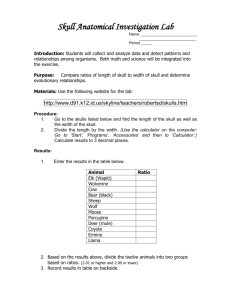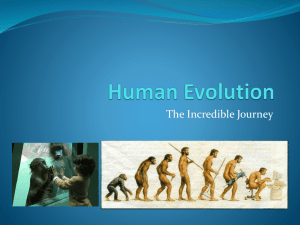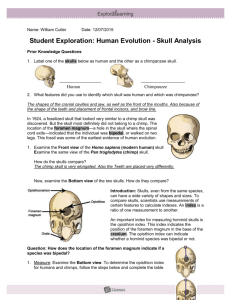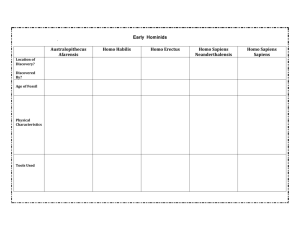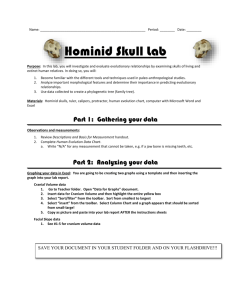File - Mrs. Loyd's Biology
advertisement
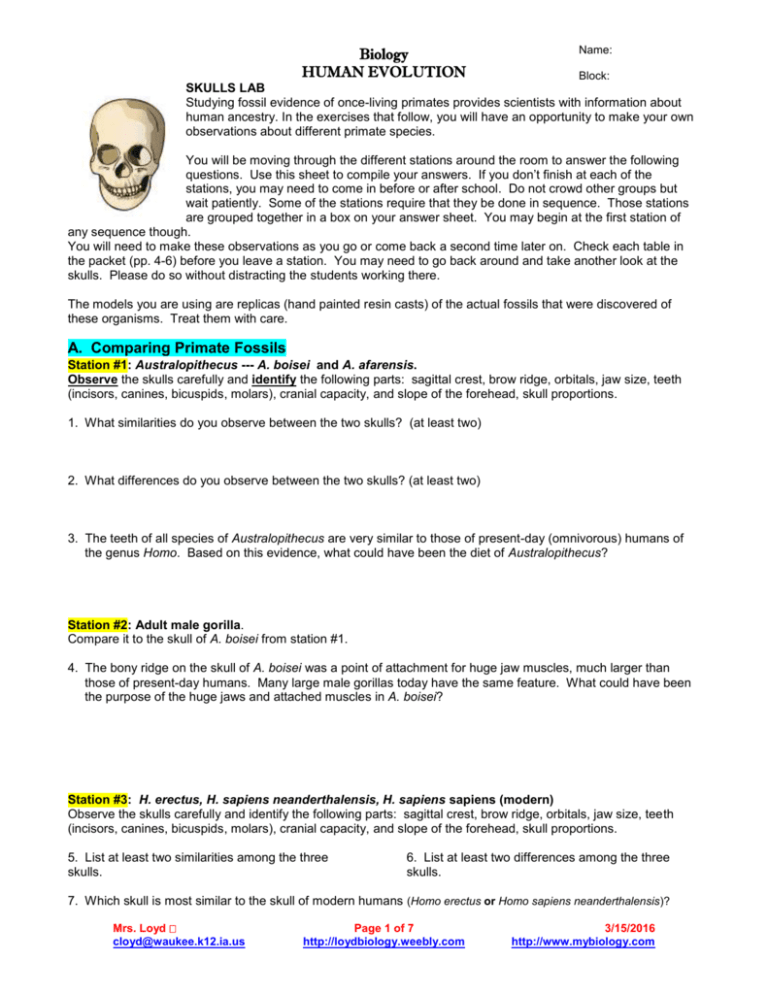
Biology HUMAN EVOLUTION Name: Block: SKULLS LAB Studying fossil evidence of once-living primates provides scientists with information about human ancestry. In the exercises that follow, you will have an opportunity to make your own observations about different primate species. You will be moving through the different stations around the room to answer the following questions. Use this sheet to compile your answers. If you don’t finish at each of the stations, you may need to come in before or after school. Do not crowd other groups but wait patiently. Some of the stations require that they be done in sequence. Those stations are grouped together in a box on your answer sheet. You may begin at the first station of any sequence though. You will need to make these observations as you go or come back a second time later on. Check each table in the packet (pp. 4-6) before you leave a station. You may need to go back around and take another look at the skulls. Please do so without distracting the students working there. The models you are using are replicas (hand painted resin casts) of the actual fossils that were discovered of these organisms. Treat them with care. A. Comparing Primate Fossils Station #1: Australopithecus --- A. boisei and A. afarensis. Observe the skulls carefully and identify the following parts: sagittal crest, brow ridge, orbitals, jaw size, teeth (incisors, canines, bicuspids, molars), cranial capacity, and slope of the forehead, skull proportions. 1. What similarities do you observe between the two skulls? (at least two) 2. What differences do you observe between the two skulls? (at least two) 3. The teeth of all species of Australopithecus are very similar to those of present-day (omnivorous) humans of the genus Homo. Based on this evidence, what could have been the diet of Australopithecus? Station #2: Adult male gorilla. Compare it to the skull of A. boisei from station #1. 4. The bony ridge on the skull of A. boisei was a point of attachment for huge jaw muscles, much larger than those of present-day humans. Many large male gorillas today have the same feature. What could have been the purpose of the huge jaws and attached muscles in A. boisei? Station #3: H. erectus, H. sapiens neanderthalensis, H. sapiens sapiens (modern) Observe the skulls carefully and identify the following parts: sagittal crest, brow ridge, orbitals, jaw size, teeth (incisors, canines, bicuspids, molars), cranial capacity, and slope of the forehead, skull proportions. 5. List at least two similarities among the three skulls. 6. List at least two differences among the three skulls. 7. Which skull is most similar to the skull of modern humans (Homo erectus or Homo sapiens neanderthalensis)? Mrs. Loyd cloyd@waukee.k12.ia.us Page 1 of 7 http://loydbiology.weebly.com 3/15/2016 http://www.mybiology.com 8. Which skull is most different to the skull of modern humans (Homo erectus or Homo sapiens neanderthalensis)? 9. What evidence do you observe that supports the hypothesis that Homo erectus walked with upright posture? You are ready for station #4 B. Classifying Fossils Several important criteria are used to determine if fossils should be classified in the genera Homo and Australopithecus or in a genus of apes. Among the characteristics that are examined are upright posture, with its associated bipedal (two-legged) locomotion, pelvic structure, and teeth structure. In the stations that follow you will have an opportunity to study these characteristics and make comparisons between species. Upright posture Upright posture can be determined from a variety of evidence. One major piece of evidence is the position of the opening in the skull (the foramen magnum) where the spinal cord exits the head. If the foramen magnum is located underneath the skull, this indicates that the skull was carried upright, similar to humans who are bipedal or walk on two legs. If the foramen magnum is located near the rear of the skull, this indicates that the skull was carried horizontally, similar to present-day apes, who do not walk upright but walk on their feet and knuckles. In 1924, a fossilized skull that looked very similar to a chimp skull was discovered. But the skull most definitely did not belong to a chimp. The location of the foramen magnum indicated that the individual was bipedal. This fossil was some of the earliest evidence of human evolution. Start by comparing two modern hominids: a human and a chimpanzee. Humans, chimpanzees, and the other great apes are hominids. Hominids evolved from a common ancestor that lived about 13 million years ago. Hominins are hominids that belong to the lineage that led to humans. See pg. 4 for a diagram. Pelvic Structure Another distinguishing feature of upright posture is the structure of the pelvis. The size and shape of the pelvic bones provide clues about how the individual walked and therefore how it should be classified. Station #4: Human pelvis, chimpanzee pelvis and Australopithecus afarensis pelvis. Draw a line mentally from the highest to lowest part on each pelvis and compare the angle made using that line and a line directly through the center of each pelvis. (In other words, which pelvis is wider and which is more upright?) Also, look at the amount of bone supporting the leg socket joint. 11. What differences do you observe between the two pelvises that would give you information about its posture? 12. Now compare the A. afarensis pelvis to the first two. Based on pelvic structure, why is Australopithecus afarensis not classified in a genus with the chimpanzee? Go on to station #8 Mrs. Loyd cloyd@waukee.k12.ia.us Page 2 of 7 http://loydbiology.weebly.com 3/15/2016 http://www.mybiology.com Station #8: Skull of Homo sapien and Pan troglodytes. Compare the skulls of a modern human and the chimpanzee. 13. Which skull is that of the modern human (Homo sapien) and which belongs to the chimpanzee (Pan troglodytes)? Use the position of the foramen magnum to identify and describe each. 14. Examine the front of the Homo sapiens skull. Then examine the same view of the Pan troglodytes skull. How do the skulls compare? Dentition Introduction: Dentition (the number and type of teeth) is another factor for determining if a fossil skull belongs to the genera Homo and Australopithecus, or to a genus of apes. Observe the skulls carefully and identify the following teeth: incisors (front for cutting), canines (fangs for holding), bicuspids (“two points” also called premolars), and molars (farthest back/grinding). Observe the dental structure in terms of types and size of teeth. 15. What are at least two similarities in tooth structure for these two skulls? 16. What is one difference in tooth structure for these two skulls? (Teeth of adult Rottweiler) Foramen Magnum Introduction: Skulls, even from the same species, can have a wide variety of shapes and sizes. To compare skulls, scientists use measurements of certain features to calculate indexes. An index is a ratio of one measurement to another. An important index for measuring hominid skulls is the opisthion index. This index indicates the position of the foramen magnum in the base of the cranium. The opisthion index can indicate whether a hominid species was bipedal or not. Question: How does the location of the foramen magnum indicate if a species was bipedal? Station #9: Skull of A. africanus, skull of H. ergaster, skull of Kenyanthropus To determine the opisthion index of each skull, follow the steps below and complete the table. Measure the distance from the opisthocranion to the opisthion, as shown at top right. Record the opisthocranion-opisthion distance in the table below. Measure from the opisthocranion to the orale, as shown at bottom right. Record the opisthocranion-orale distance in the table. Move to the next station to do your calculations. Station 10: Desk work: To calculate the opisthion index, divide your first measurement by your second measurement. Multiply this number by 100. Example: A. afarensis: 2.7 ÷ 16.2 x 100 = 16.7 Mrs. Loyd cloyd@waukee.k12.ia.us Page 3 of 7 http://loydbiology.weebly.com 3/15/2016 http://www.mybiology.com Species Opisthocranionopisthion distance (cm) Opisthocranionorale distance (cm) Opisthion index A. afarensis 2.7 16.2 16.7 A. bosei 3.9 19.7 H. habilis 4.1 16.7 H. erectus 4.6 20.6 5.0 21.5 Pan troglodytes 2.2 18.2 Gorilla gorilla 1.75 24.0 A. africanus H. ergaster H. sapiens neanderthalensis Kenyanthropus Humans, chimpanzees, and the other great apes are hominids. Hominids evolved from a common ancestor that lived about 13 million years ago. Hominins are hominids that belong to the lineage that led to humans. Analyze: An opisthion index greater than 15 means that the foramen magnum is situated close to the center of the cranium. This position is usually found in species that stand upright. An opisthion index less than 15 means the foramen magnum is situated in the rear of the cranium. This position is found in species that walk on their knuckles or on four legs. Drawing conclusions: Using the index values you calculated, what can you conclude about which skulls belonged to a species that was bipedal? 15. __________________________________________________________________________________________ __________________________________________________________________________________________ Analyze: Hominins are characterized by bipedalism. 16. Based on their opisthion indexes, which of the hominids are hominins? __________________________________________________________________________________________ __________________________________________________________________________________________ __________________________________________________________________________________________ 17. Based on opisthion indexes, which hominin skulls are most similar to human skulls? __________________________________________________________________________________________ __________________________________________________________________________________________ 18. Why do you think the foramen magnum is positioned near the rear of the cranium for knuckle-walking species and near the center of the cranium for bipedal species? __________________________________________________________________________________________ __________________________________________________________________________________________ __________________________________________________________________________________________ Mrs. Loyd cloyd@waukee.k12.ia.us Page 4 of 7 http://loydbiology.weebly.com 3/15/2016 http://www.mybiology.com Cranial Capacity: Measure skulls as you go! Introduction: The brain is housed inside the cranium. The internal volume of the cranium is called the cranial capacity. The larger an organism’s cranial capacity is, the larger its brain tends to be. Station #11: Skull of A. africanus, skull of H. ergaster, skull of Kenyanthropus Question: How does the cranial capacity compare amongst hominids? Measure the diameter of the circle in cm (use the circles on the pictures at each station. This represents the part of the cranium that houses the brain. The photographs are not to scale. (The diameter is the distance across the exact center of each circle.) Multiply the cranial diameter by 200 cm2. This gives the cranial capacity (brain volume) in cubic centimeters. Record your data in the table below. Pan troglodytes Homo sapiens Station 12: Desk Work: Calculations Analyze: Examine the estimated cranial capacities you calculated. 19. Which species probably had the largest cranial capacities? ____________________________________ ____________________________________ ____________________________________ Species A. afarensis Cranial diameter (cm) Estimated cranial capacity (cm3) ---- 375-500 ---- 800-1,000 ---- 1,450 A. africanus A. bosei ____________________________________ H. habilis 20. What do you think cranial capacity is a good H. erectus indicator of? H. ergaster ____________________________________ H. sapiens neanderthalensis ____________________________________ Australopithecus afarensis ____________________________________ Kenyanthropus ____________________________________ H. sapiens ---- 1,350 ____________________________________ P. troglodytes ---- 380 ____________________________________ ---500 G. gorilla 21. Did any hominids have a larger cranial capacity than humans? If so, which species? _________________________________________________________________________________________ _________________________________________________________________________________________ _________________________________________________________________________________________ Mrs. Loyd cloyd@waukee.k12.ia.us Page 5 of 7 http://loydbiology.weebly.com 3/15/2016 http://www.mybiology.com Compare: Compare the size and shape of the foreheads, brow ridges, and sagittal crests (the bony ridge running across the top of the skull; may be absent) of the skulls to each other and the skull of a modern human. 22. Which skull shares the most similar features with modern humans? Which one is the most dissimilar? _________________________________________________________________________________________ 23. Why do you think humans have such large foreheads and lack both the prominent brow ridge and sagittal crest? _________________________________________________________________________________________ Draw conclusions: Compare the data you collected in activity A with the data you collected in this activity. 24. Which evolved first in hominins: bipedalism or large brains? Explain. _________________________________________________________________________________________ _________________________________________________________________________________________ _________________________________________________________________________________________ Station 13: Desk work. Revisit stations as needed. Maxilla and Mandible Introduction: Teeth and the bones around the mouth give a great deal of information about both a species’ diet and how it eats. Take a look at the skull features below. Question: How do the mouths of hominids compare? Angles have been measured for you. Measure: Position the protractor as described. The protractor’s vertex/center at the top of the nasal opening (Hint: You may have to look at the Front view in order to see where the top of the nasal opening is in relation to the orbit). On the top of the zygomatic process (cheek bone), level the bottom of the protractor. Now measure the maxillary angle using the protractor. Measure from the zygomatic process to the teeth. Complete the table. (Note: You will not be able to do this measurement on incomplete skulls.) Species Maxillary angle Palate Shape (U or V?) Homo sapiens 90 V Australopithecus afarensis 120 Australopithecus africanus 131 Australopithecus bosei 123 Homo habilis 105 Homo erectus 96 Homo ergaster 91 Homo sapien neangerthalensis 115 Kenyanthropus platyops 102 Pan troglodytes 150 Gorilla gorilla 140 Describe: Next examine the size and shape of each species palate. The shape will be a U or a V shape. Record your observations in the table. You may need to go back around and take another look at the skulls. Please do so without distracting those students working there. An angle of more than 90 degrees means the lower jaw sticks out in front of the nose. An angle of 90 degrees means the lower jaw does not stick out in front of the nose. Mrs. Loyd cloyd@waukee.k12.ia.us Page 6 of 7 http://loydbiology.weebly.com 3/15/2016 http://www.mybiology.com U 26. Observe: How does the maxillary angle and palate shape relate to the size of each species’ mouth? You may need to go back around and take another look at the skulls. Please do so without distracting those students working there. _________________________________________________________________________________________ _________________________________________________________________________________________ 27. Compare: Compare the number, size and shape of the teeth for each species. What can the teeth tell you about that species diet? How does comparing the teeth and jawbones of each species allow you to determine relatedness to each other? _________________________________________________________________________________________ _________________________________________________________________________________________ 28. Infer: What is the relationship between the evolution of bipedalism, the increase in cranial capacity, and the decrease in tooth and mouth size of hominids? Is there a trend within the hominins? (Hint: As cranial capacity increased, the use of sophisticated stone tools became more common.) _________________________________________________________________________________________ _________________________________________________________________________________________ 29. Summarize: Record the age of each fossil. Then, look over all the data you collected. Summarize how hominins changed as they evolved. _________________________________________________________________________________________ _________________________________________________________________________________________ _________________________________________________________________________________________ _________________________________________________________________________________________ Species Age (mya) Homo sapiens Activity C Time Line Record the age of each hominin skull in the chart. You can find it on the colored information card that accompanied each skull. Use that data to create a timeline to show the order of when each specimen existed. Make a note on the timeline for “large brain” and “bipedal.” Australopithecus afarensis Australopithecus africanus Timeline (million years ago) Australopithecus bosei __________________________________________________________ 4.0 3.0 2.0 1.0 present Homo habilis Homo erectus Homo ergaster Homo sapien neangerthalensis Kenyanthropus platyops Pan troglodytes ------ Gorilla gorilla ------ Mrs. Loyd cloyd@waukee.k12.ia.us Page 7 of 7 http://loydbiology.weebly.com 3/15/2016 http://www.mybiology.com



